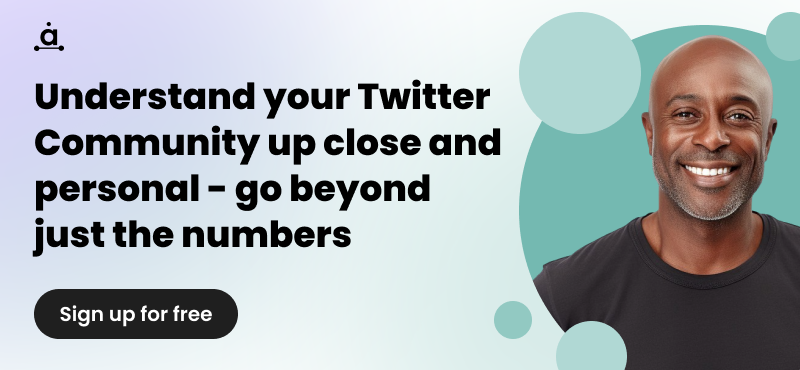How to create a Twitter marketing strategy that drives results
There’s no social media company that had a more eventful year than Twitter, going through a major acquisition, multiple feature updates, and countless news stories. But the social public square closed out the year serving an estimated 368 million users worldwide and is still an invaluable platform for connecting brand and audience.
Understanding how you can use Twitter to effectively reach potential customers with unique content and experiences should be at the top of your list.
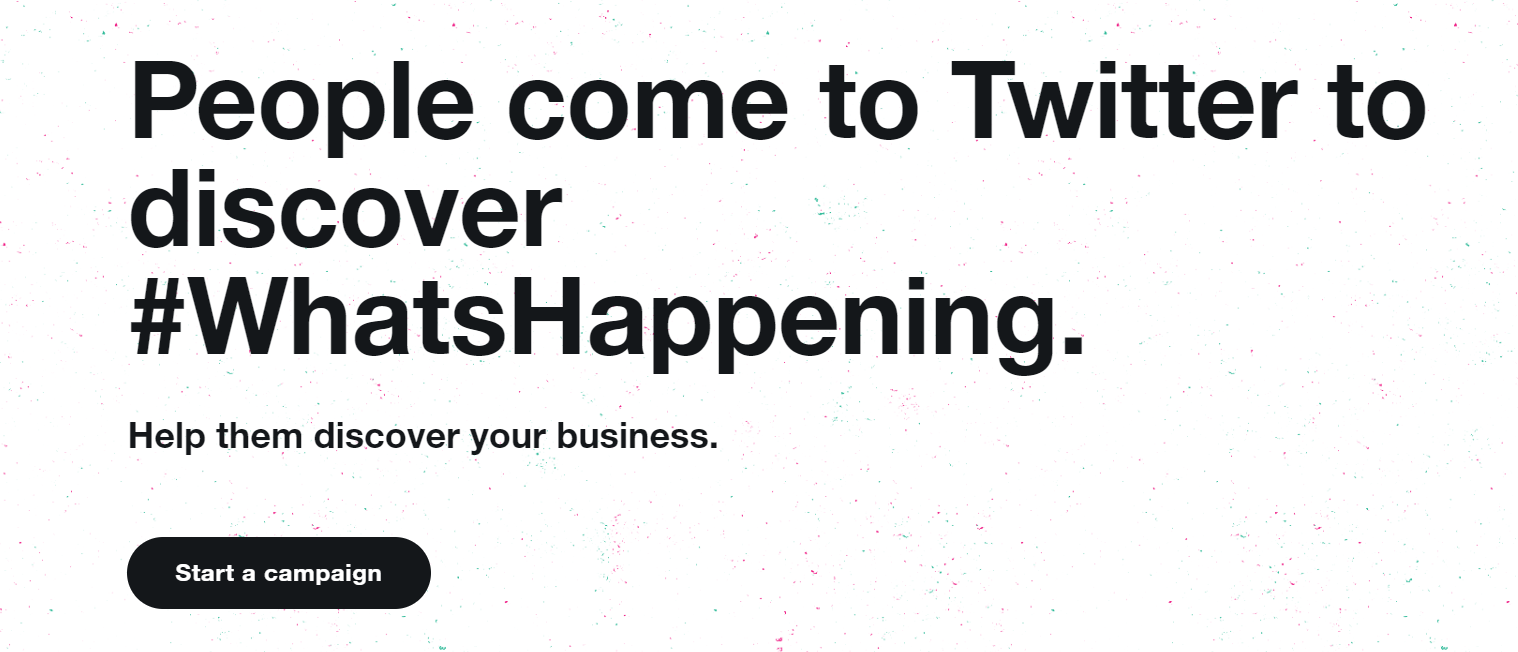
Today we're taking a deep dive into the components of a successful Twitter marketing strategy. We’ll discuss all the key steps involved in planning, building, and executing Twitter campaigns that resonate with your audience. From setting realistic goals for success, creating compelling content formats suited for maximum engagement performance, through optimizing user experience across various devices — it’s all here waiting for you!
Why a Twitter marketing strategy is essential
Despite the fact that Twitter is an older social media company that’s been around since 2006, Twitter is actually growing in popularity among Gen Z users. Here are a few reasons why you need to consider Twitter as part of your marketing strategy:
- Twitter is the number one social media site for getting news
- Twitter is expected to reach nearly 500 million global users by 2025
- The largest cohort of Twitter users are 24 to 35-years-old
- The United States has nearly 77 million Twitter users
- The number of American Twitter users with a salary of $75K and above is 9% higher than that of the general population
So, while it may not have the viral hype of TikTok or the dominant presence of Instagram, Twitter is still a very effective tool for reaching a growing cohort of information seekers who have a higher average income.
What is a Twitter marketing strategy?
Twitter took the social media world by storm with its quick and efficient format. It has become an indispensable tool for marketers trying to reach their audience. The question is, what is a Twitter marketing strategy?
It's more than just randomly posting tweets every time you feel like it. It involves creating a plan that aligns with your goals, targeting your desired audience, and engaging with them in a meaningful way using a variety of engaging post formats.
.png?width=1895&height=903&name=image6%20(1).png)
A successful strategy involves understanding your audience, timing your tweets, using hashtags, and monitoring your results to continually improve. With a well-crafted Twitter marketing strategy, you can reach new audiences and build a loyal following that translates into business success.
What makes Twitter a great marketing tool?
Twitter offers a platform for businesses to engage with their customers and build brand awareness. One of the reasons Twitter is such a great marketing tool is its real-time nature. You can share updates, promotions, and news instantly, keeping your followers in the loop and building a sense of community.
It also has a range of content formats and features — threads, lists, polls, targeted ads, and more — to make sure your messaging is even more effective (more on those later).
Another reason Twitter is so effective is its ability to connect businesses with influencers and thought leaders in their industry. By leveraging these connections, businesses can expand their reach and gain valuable insights.
If your company is targeting a predominantly male consumer segment, Twitter needs to be a part of your marketing strategy — over 62% of its audience is male.
Overall, Twitter is an incredibly powerful marketing tool that can help businesses of all sizes increase their visibility and connect with their audience in a meaningful way.
How Twitter marketing benefits your business
When it comes to marketing your business, social media can be a game-changer. Twitter is one platform that you definitely don't want to overlook. With millions of daily active users, Twitter can help you connect with your audience in real-time and ignite conversations around your brand.
But that's not all: Twitter marketing can also help increase your brand's visibility, qualify leads, and sell products. Just look at these stats from Twitter’s business page:
- Twitter is the top social media platform for discovery and news
- Twitter users spend 26% more time viewing ads than those on other platforms
- 53% of Twitter users report being more likely to adopt new products early
While your company’s Twitter journey may have started with increasing brand exposure and strengthening relationships with followers, it’s important to remember that the platform can help contribute to the bottom line when used in the right way.
Now let’s take a closer look at the steps involved in building a Twitter marketing strategy.
Creating a Twitter marketing strategy
Crafting a Twitter marketing strategy can seem intimidating, especially with all the changes that have occurred in the last calendar year. By following a few key steps, you can help make the process smoother.
1. Define your goals and objectives for your Twitter marketing strategy
Setting goals and objectives is essential for success in any marketing initiative. Twitter is no different. Whether you're looking to increase brand awareness, drive website traffic, or engage with your audience, having a clear purpose in mind will help guide your strategy.
Take time to define your goals and objectives. Think about what you want to achieve and how Twitter can help you get there. Make sure you set SMART goals to position your campaign for success.
Here are some of the key steps involved in this process.
Audit your Twitter account
Auditing your brand account gives you a chance to review the current standing of your Twitter presence and audience behavior. At this stage it’s important to keep an eye out for the following:
- Profile information and brand imagery
- Level of consistency in post format and message
- Alignment between content and company goals
- Follower demographics and growth rate
- Engagement rate and lead capture
Once you have established the baseline performance of your Twitter profile, you can move to the next stage of setting measurable goals.
Set measurable Twitter goals
Start by defining what you want to achieve with your tweets. Do you want to build your brand presence with more followers, retweets, or website traffic? Once you have a clear objective in mind, choose specific metrics to measure your success.
For example, if your goal is to increase website traffic, your metric may be the number of clicks on your pinned tweet. Always make sure your goals are achievable and relevant to your overall social media strategy.
Don't forget to regularly check your progress and adjust your goals as needed.
Check out the competition
It's always wise to keep an eye on the competition. Checking out what your industry rivals are up to not only gives you fresh ideas but also helps you identify potential blind spots in your own business strategy.
When you take the time to study your competitors on Twitter, you learn a lot about industry trends, the latest products and services, and what customers are looking for. By analyzing their strengths and weaknesses, you can make better-informed decisions about where to focus your efforts and how to stand out from the crowd.
Don't forget to check in with your competition on Twitter — it might just give you the edge you need.
2. Identify and understand your target audience on Twitter
Twitter’s ability to connect mass audiences with trending content is unprecedented. In order to make the most out of this phenomenon, your brand needs to identify and understand your target Twitter audience.
While it may seem overwhelming at first, it's critical to recognize that doing so can maximize engagement on your tweets, attract more followers, and ultimately drive purchase decisions. But to build this type of impactful relationship, you first need to understand some key demographic information about your audience, including:
- Age range
- Interests and values
- Geographic location
- Occupation
- Engagement behavior
This information, when paired with social listening data, can be used to create in-depth personas that increase brand relevance and make it easier to tailor your messaging to your audience.
Tune in with social listening
Social media platforms like Twitter are as well suited for consumer research as they are for communication, so tuning in to what people are saying about your brand is key.
Social listening allows you to keep your finger on the pulse of public opinion, helping you to identify potential issues before they escalate and giving you the opportunity to respond to customer feedback. By monitoring all conversations related to your brand, you can gain insights into what your customers value and what they are saying about your competitors.
Your company can use this information to inform marketing strategies, enhance product offerings, and deepen customer loyalty. With social listening, you have a powerful tool that can help your business stay ahead of the curve in today's ever-changing digital landscape.
Use audience intelligence
Having a strong online presence is paramount, but how do you ensure that you're targeting the right audience? This is where an audience intelligence tool comes into play.
Audience intelligence tools help you identify the topics, keywords, and profiles that resonate with your target demographic. By analyzing user behavior on social media sites like Twitter, tools like Audiense Insights can give you valuable insights into what your potential customers are interested in, helping you create more effective marketing campaigns.
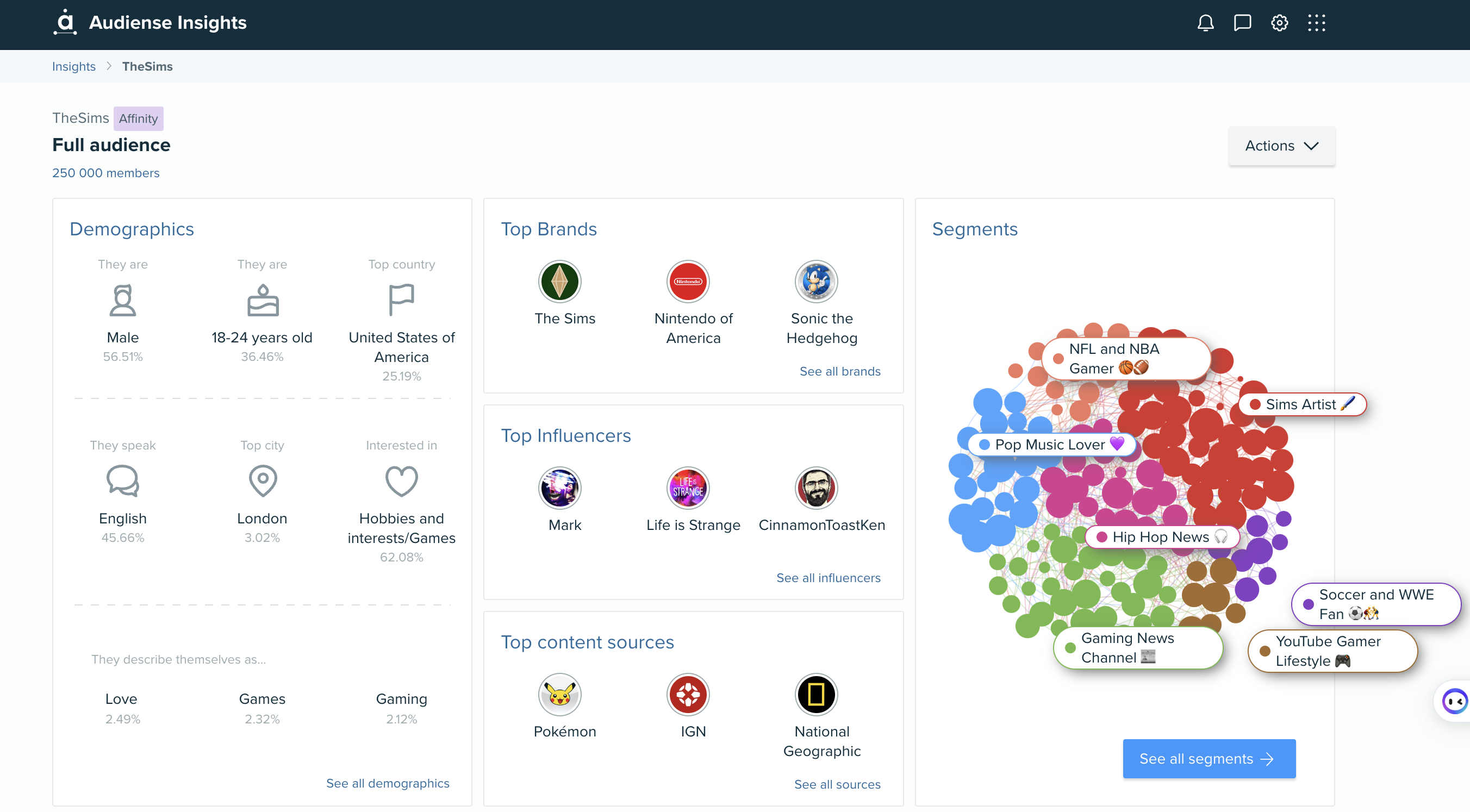
Audience intelligence tools can also enrich the data you get from using Twitter or other third-party tools for social listening.
Discover when to tweet
The majority of your audience likely has a screen near them at all times, so it can be tempting to think that any time is a good time to tweet. While there is no one-size-fits-all answer for the best time to tweet, there are some general guidelines to follow from post scheduling companies like Buffer and Sprout.
-2.png?width=697&height=491&name=image2%20(1)-2.png)
Weekdays: Tweet between 9 a.m. and 12 p.m. to increase the chance that you catch people checking their feeds during breaks or downtime.
Weekends: Afternoon hours tend to yield higher engagement levels.
Additionally, it’s important to consider your specific audience and their likely patterns of social media use. If you are targeting an overseas audience or segment in a different timezone, you will want to take that into account as well.
It’s also helpful to experiment with different posting times. As you collect more engagement data, you can break down results by posting time to uncover more context about ideal tweet timing.
Schedule tweets ahead of time
Scheduling tweets ahead of time will be a game changer for your brand. Not only does it save on manual tasks, but it also ensures that followers are getting relevant content on a consistent and timely basis. Once you’ve identified the ideal times for tweeting throughout the week, it’s a simple matter of updating delivery times with your scheduling tool.
Here are a few options for scheduling your tweets in advance:
- Social media scheduling tools like Buffer, Sprout Social, and Hootsuite
- Using the Schedule Tweets feature on Twitter’s advertising platform
With the ability to write and schedule tweets in advance, you never have to worry about missing a key moment or deadline. Scheduling tools are a simple addition to your Twitter marketing strategy that can have a major impact on engagement.
How many times should you tweet in a day?
The question of how many times one should tweet in a day is another hotly debated topic in the Twitterverse. While some experts recommend posting up to 15 times a day, others caution against overloading followers' feeds with too many tweets and opt for around four to five times.
The answer for your particular business will depend on a variety of factors, including:
- Industry and niche
- Type of content
- Type of engagement
- Audience behavior
While quantity can be important, you don’t want to prioritize it over quality and engagement. Any tweet should provide value to your followers, whether it's through educational, empowering, or entertaining content.
Tweeting consistently can build a loyal fanbase and make your tweets stand out in a crowded digital landscape. Just make sure you are monitoring engagement levels and revising your daily number of tweets based on the preferences and behavior of your audience segments.
3. Develop a content strategy that aligns with your goals and audience
Developing a content strategy is a crucial step in achieving your online goals. It's not just about creating content for the sake of it; it's about understanding your audience and tailoring your content to their needs.
To be effective, your strategy needs to align with your business objectives and the affinities of your target audience. This means taking a deep dive into Twitter analytics, personas, and user research to understand their pain points, preferences, and behaviors. By doing so, you can create content that resonates with them and drives engagement.
Whether you're looking to increase brand awareness, generate leads, or improve customer loyalty, a well thought out content strategy can help you achieve your goals.
Make a content calendar
Creating a content calendar is a key component of any successful social media workflow. By mapping out the next month’s or quarter’s content in advance, you'll be able to ensure that your Twitter posts are aligned with the rest of your marketing strategy and your overall business goals.
Plus, having a clear schedule will help you stay accountable and consistent, which is crucial for building a loyal audience.
Use visuals for higher engagement
Humans are visual creatures, so it’s no surprise that incorporating visuals into your content can significantly increase engagement. From images to videos and infographics, using visuals helps to capture and hold your audience's attention.
Visual Twitter content doesn’t just have to be all customer infographics or animations, you can leverage a number of other types to increase engagement, including:
- Product images
- User-generated content from other platforms
- Screenshots from your website or blog
- Video demonstrations
- Memes
Twitter cards are a particularly important tool for improving your performance with visual content as this feature allows you to post more dynamic types of content in tweets.
Identify the optimal tweet length — 140 characters or 280 characters
For the first decade of Twitter’s existence, tweets were limited to 140 characters. But, in 2017, the company doubled the limit to 280 characters, stating that the limit hindered user’s ability to communicate.
This increased character limit has sparked debate among Twitter users about the optimal tweet length. Some argue that shorter tweets force users to be concise and creative with their messages while others contend that longer tweets allow for more nuanced discussions and more detailed explanations.
With more changes looming, the most important thing for brands and marketers to worry about is the quality of the content and the ability to match messaging to audience affinities.
Target specific audience segments with Twitter Ads
Organic Twitter posts aren’t the only way to get your brand, product, and service in front of a specific audience — you can also deliver targeted Twitter Ads to specific audiences using multiple platforms.
Twitter itself has ad bidding and analytics features, similar to Google Ads, that let you bid on relevant keywords, deliver content to specific regions or at specific times, and even place them around native content like Tweets, Replies, and Search. But, with thousands upon thousands of businesses and brands using similar features to reach their audiences, you need some help standing out.
Tools like Audiense Connect help you curate static or dynamic audiences to deliver your Twitter Ads to the people that are most likely to respond to them. With this tool, you can pre-set your ad audiences or set them up to automatically adjust based on specific behaviors.

4. Use hashtags and trending topics to increase your reach
As the first social media company to use hashtags as a way to categorize messages more effectively, Twitter has always been an effective way to connect users with the topics that interest them. Since then, they’ve also developed a trending topics feature that helps you identify what is interesting to people in specific geographic areas.
These two features are especially important for brand marketers, so let’s take a closer look at them.
Are Twitter hashtags still relevant?
Yes, the hashtag is still a vital component of Twitter. It’s an efficient way to categorize similar tweets and identify the profiles, personalities, and perspectives that specific topics attract.
The hashtag has come a long way since its introduction in 2007. What was initially an easy way to search for tweets has become a powerful tool for driving conversation, awareness campaigns, and social movements. Hashtags have become an essential part of social media marketing, with businesses using them to improve their visibility online and capture traffic from trending topics.
For instance, Twitter found that tweet volume for #TVTwitter and TV-related increased to nearly 5 million per week in 2022 as the number of hit shows across streaming platforms continues to grow.
How to identify trending topics on Twitter
A trending topic is a word, phrase, or hashtag that is currently being used more than other topics at a given moment. This could be related to a news event, a celebrity, or a viral meme.
To identify trending topics on Twitter, you can start by looking at the “Trending” section on the left side of your homepage. Here, Twitter will show you the top ten topics that are being talked about the most. You can also use the search bar to search for a specific topic or hashtag.
If it’s trending, it will show up in search.
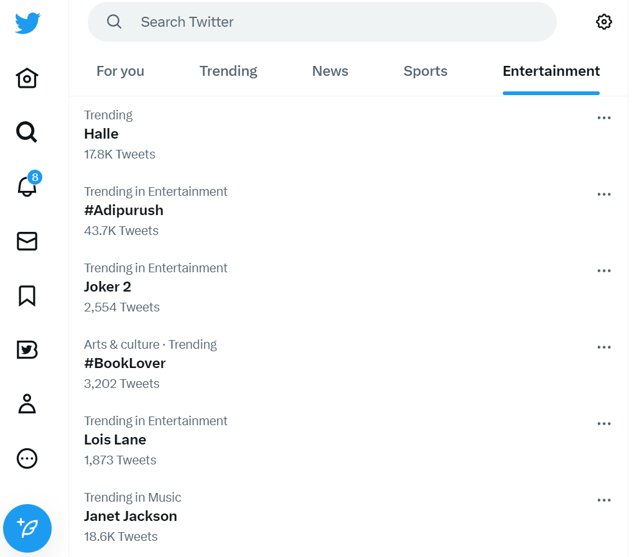
You can also use third-party tools, such as Hootsuite, Trendsmap, Tweet Binder to see more detailed information on what topics are trending in specific locations or industries.
Have a Twitter topic or #hashtag you want to analyze? Enter it into our Tweet Binder tool below to get the a free analytics report from the last 7 days:
5. Engage with your audience and build a community on Twitter
Twitter is more than just a platform to share your thoughts and opinions. It's a powerful tool to engage with your audience and build a community around your brand or message.
Businesses can take advantage of multiple tweet formats and specific features to make their content more engaging and impactful — from threads and visuals to polls and giveaways.
Let’s take a look at how you can use these content types as part of your Twitter marketing strategy.
Enhance your Twitter presence by engaging with your followers
Twitter is a great tool for influencers and businesses alike to connect with their audiences and engage with followers consistently. This means responding to their tweets, retweeting their content, and starting conversations.
Building genuine connections with your audience can help increase your reach, boost your credibility, and even drive sales. Of course, they don’t always have to be serious and meaningful — sometimes it’s enough to just provide your followers with some entertainment.
Wendy’s #NationalRoastDay post is the perfect example of the latter. The fast food chain’s marketing team invites their followers to be roasted and provides the perfect opportunity to plug the Wendy’s app.
Roast me!
— Chef Mike Haracz canceled his subscription (@Mike_Haracz) January 12, 2022
With over 31,000 likes, 3000 retweets, and hundreds of comments, this single post proved incredibly successful at engaging Wendy's followers while also driving purchase behavior.
Create Twitter threads
By stringing together multiple tweets into a cohesive narrative, you can create a powerful and engaging story that's sure to grab your followers' attention. Whether you're sharing news, telling a personal story, providing a detailed explanation, or promoting your brand, Twitter threads can help you create a more nuanced and impactful message.
Threads are especially popular among topic experts, professionals, and popular influencers who want to dive deep on a particular topic.
This 20 part thread from solopreneur and investor Justin Welsh on how he built his one-person business to $3 million in revenue is an incredibly engaging example of how a brand can dive deep on a topic using Twitter.
Today, my little one-person business crossed $3M in revenue.
— Justin Welsh (@thejustinwelsh) November 7, 2022
It took 1,187 days, I ran zero ads & operate at a 94% margin.
Here are the 20 steps of my wild & strange journey:
Hope it's helpful to someone.
[🧵 thread]
Elevate engagement by utilizing visuals on Twitter
Utilizing eye-catching images, captivating gifs, and informative infographics can help you elevate engagement, boost your brand's visibility, and drive traffic to your website. They can improve the readability and shareability of your content.
Designed graphics and video content are a must-use for all types of businesses, but they are particularly useful in industries like gaming and sports.
For instance, the viral online game Fortnite regularly puts out visual content on its Twitter to showcase product updates or announce new collaborations. The marketing team recently posted a video on Twitter to announce the rollout of a new lock-on game feature.
The video earned over 250K full views and 1.1M impressions in 24 hours.
Always on the move? Don't let your aim slip with the new Lock On Pistol! pic.twitter.com/uQHUTxyiGr
— Fortnite (@FortniteGame) April 18, 2023
Create Twitter lists to organize your content
Twitter lists are organized groups of Twitter accounts you’ve selected and put together in specific categories, with each list only displaying Tweets from the selected accounts.
.png?width=620&height=709&name=image5%20(2).png)
Twitter lists can be used to segment accounts for a range of purposes, like:
- Business inspiration
- Competitor research
- Industry trends and news
- Target audience monitoring and engagement.
This makes it simple to easily review the posts, interactions, and content for specific user groups. Plus, you can even create private lists so you can curate content for specific audiences without everyone seeing.
Extract valuable insights by conducting Twitter polls
Twitter is also a great tool for extracting insights from your audience segments in real-time using Twitter polls. With this feature you can customize questions and target specific demographics for a quick and easy way to gauge public opinion.
What best describes your savings Vault?
— Revolut (@RevolutApp) April 1, 2022
Additionally, Twitter polls can be shared and reposted, making it an effective way to increase engagement and reach. From product feedback to current events, Twitter polls offer a unique opportunity to gain valuable insights that can inform future decisions.
Execute a Twitter giveaway contest to boost engagement and amplify your brand
Getting your brand noticed on social media can be a struggle, but a Twitter giveaway contest could be the key to boosting engagement and providing a positive experience to your followers. By establishing giveaway entry criteria, like having users tag a friend or create hashtagged user-generated content (UGC), these initiatives are a great way to expose your brand to a much larger pool of potential customers.
With the right planning and execution, a Twitter contest can help you grow your following, increase brand awareness, and encourage user-generated content. By giving away prizes that are relevant to your brand, you can also attract the attention of potential customers who may not have discovered you otherwise. With a little creativity and a clear set of rules, your Twitter giveaway contest could be the talk of the platform and deliver a significant ROI for your business.
Giveaways are a popular social media strategy and Twitter is no exception, there are plenty of examples of brands that use this tactic on Twitter to spread brand awareness and drive engagement.
5. Understand the importance of consistency in your Twitter marketing strategy
In the fast-paced world of Twitter, consistency is the key to unlocking success for your brand. Consistency means more than just tweeting regularly; it also means using consistent messaging, branding, and tone of voice to make sure that your tweets are recognizable and memorable to your audience.
With consistency in your Twitter marketing strategy, you can build trust with your followers, establish your brand identity, and ultimately, drive engagement and sales. Developing a social media style guide is a great way to ensure that your content and visuals consistently support the brand voice and personality you want to convey to your audience.
Here are three key reasons why a consistent Twitter marketing strategy is important for your brand.
-
Consistency builds trust and credibility with your audience
When you post Twitter content that adheres to your brand values, principles, and image, you demonstrate to your audience that you are reliable, trustworthy, and committed.
This, in turn, fosters a sense of trust and loyalty, as your audience begins to view you as a credible source of information and a dependable provider of goods or services. So don't underestimate the power of consistency. Invest in it, and watch as your audience grows and your influence expands.
-
Consistent brand voice and messaging can differentiate your brand
A consistent brand voice and messaging differentiates your brand from competitors and builds a connection with your audience.
When your customers hear or see your brand, they should instantly recognize who you are and (hopefully) what you stand for. Whether it's by posting witty, entertaining content like Wendy’s or consistently using visuals like Fortnite, use your Twitter content to make your brand stand out from the rest.
-
Consistent posting and engagement increases Twitter reach and visibility
By regularly creating and sharing content, you keep your current followers engaged and attract new ones through likes, retweets, and quote shares. So, if you want to make the most out of your presence on Twitter, make sure to stay active and engage with your audience.
Measuring and analyzing your Twitter strategy for success
Measuring and analyzing your Twitter strategy is essential to ensure that your efforts are effective and reach your target audience. By tracking your tweets, followers, engagement rates, and click-through rates, you can analyze the data and adjust your strategy accordingly.
You can also use an audience intelligence tool to take a closer look at specific segments of your Twitter audience. If you have a certain cohort of followers that are lacking in engagement, you can look at them more closely to identify the content types that are more likely to resonate with them.
With the right metrics, you can monitor your Twitter performance and optimize your strategy to boost your engagement rate and drive more followers towards your products and services.
What’s a good engagement rate on Twitter?
Engagement rate is the percentage of people who interact with your content, whether through likes, retweets, comments, or other interactions. Definitions for engagement can shift slightly from business to business, but there are generally accepted formulas like this one from The Online Advertising Guide:
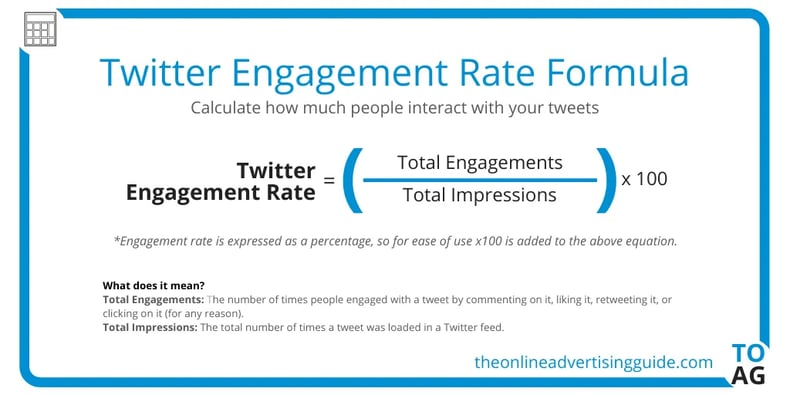
An engagement rate of 1-3% is considered by many to be a good benchmark. With that said, it’s important to also consider the industry you’re in, the size of your following, and the relevance of your content.
In the end, what matters most is that you are engaging with your audience in a meaningful way, creating valuable conversations and building relationships.
Evolving your Twitter strategy as the platform changes
Social media strategies constantly change as brands adapt to new trends and evolving consumer sentiments. Pairing this with the developments that have occurred since Elon Musk acquired the platform in 2022 and the practice of monitoring your Twitter strategy becomes even more important.
Staying updated on Twitter's algorithm changes and new features
In the fast-paced world of social media, it seems like algorithm changes and new features rollouts occur every other week. But this process has accelerated for Twitter, as the entire organization continues to experience internal changes.
To keep your Twitter game strong, it is essential to stay informed about these changes and how they may affect your account. The Developer’s Changelog provides a list of changes to the Twitter API and should be something you check regularly.
You can also keep tabs on the platform's changes by following the Twitter API, developer, and business accounts.
Adapting your strategy to reflect changing trends and the evolving interests of your audience
Adapting your Twitter marketing strategy to reflect the latest changes is crucial to your brand’s relationship with consumers. It's no longer enough to simply rely on what worked in the past — you must be willing to evolve and adjust your approach to stay relevant.
You need to regularly check on your performance with Twitter’s analytics dashboards, and regularly audit your account to find new weaknesses and areas of strength.

Aside from Twitter’s internal tools, you can also use social listening and audience intelligence tools to gain a deeper understanding of your target audience’s online behavior as they move across multiple platforms.
Take action on your Twitter marketing strategy
In the fast-paced world of social media, having a solid Twitter strategy is essential if you want to stand out from the crowd — particularly if you’re a brand that wants to be positioned ahead of the curve.
With this in mind, it's more important than ever to take action and refine your approach to ensure you're making the most of this powerful platform. Whether it's increasing your engagement, growing your follower count or building your brand, there are plenty of ways to optimize your Twitter presence and efficiently achieve your goals.
Audiense Connect is the perfect tool for brands looking to drive results with their Twitter marketing strategy . Audiense Connect helps you manage, understand, and improve your Twitter audience with a suite of key features:
- In-depth community management and analysis
- A chatbot builder for direct engagement with followers
- Global access to real-time and historical Twitter content
- Synchronization with your Ads account to create high-performing tailored audiences
Audiense Connect automates management and analysis of your Twitter followers, giving you more time to focus on the specific segments that will help you drive more results.
Key takeaways
Despite all the changes over the past year, Twitter still commands a healthy monthly active user base of over 350 million people. Given how popular the platform is among early product adopters and other key demographics, it’s a lock that Twitter will be useful to the performance of your brand.
Creating a Twitter marketing strategy that impacts the key consumer segments you want as your customer is an essential part of establishing your brand’s online presence.
We went over all the key components that go into creating a winning Twitter marketing strategy, including:
- Defining your goals and objectives
- Identifying and understanding your audience
- Developing a content strategy that aligns with your goals
- Using hashtags, trends, and key features
- The importance of a consistent strategy
- Measuring and analyzing your performance
- Keeping an eye on platform changes
To ensure that your Twitter strategy outperforms your direct competitors and other brands garnering for your audience’s attention, the above is just a start.
You need an audience research tool that helps you effectively manage your Twitter followers, while enriching your understanding of the different consumer segments that constitute it.
Audiense Connect provides all the tools you need to achieve and maintain an edge over your competitors on Twitter.







